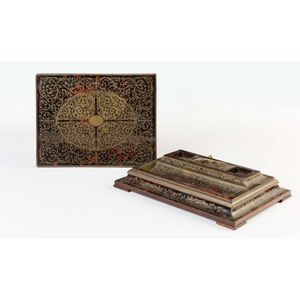Chinese Ivory Fan in Export Lacquered Box, 1870
You must be a subscriber, and be logged in to view price and dealer details.
Subscribe Now to view actual auction price for this item
When you subscribe, you have the option of setting the currency in which to display prices to $Au, $US, $NZ or Stg.
- Circa - A Latin term meaning 'about', often used in the antique trade to give an approximate date for the piece, usually considered to be five years on either side of the circa year. Thus, circa 1900 means the piece was made about 1900, probably between 1895 and 1905. The expression is sometimes abbreviated to c.1900.
- Ivory - Ivory is a hard white material that comes from the tusks of elephants, mammoth, walrus and boar, or from the teeth of hippopotamus and whales. The ivory from the African elephant is the most prized source of ivory. Although the mammoth is extinct, tusks are still being unearthed in Russia and offered for sale.
Ivory has been used since the earliest times as a material for sculpture of small items, both in Europe and the east, principally China and Japan.
In Asia ivory has been carved for netsuke, seals, okimono, card cases, fan supports, animals and other figures and even as carved tusks.
In the last 200 years in Europe ivory has been used to carve figures, for elaborate tankards, snuff boxes, cane handles, embroidery and sewing accessories, in jewellery and as inlay on furniture. Its more practical uses include being used for billiard balls, buttons, and a veneers on the top of piano keys.
The use and trade of elephant ivory have become controversial because they have contributed to Due to the decline in elephant populations because of the trade in ivory, the Asian elephant was placed on Appendix One of the Convention on International Trade in Endangered Species (CITES), in 1975, and in January 1990, the African elephant was similarly listed. Under Appendix One, international trade in Asian or African elephant ivory between member countries is forbidden. Unlike trade in elephant tusks, trade in mammoth tusks is legal.
Since the invention of plastics, there have been many attempts to create an artificial ivory - Lacquered Lacquerware - Lacquer is a clear or coloured resin that is obtained from the sap of several species of trees in the genus Rhus, particularly the Rhus verniciflua tree, which is native to China and Japan. The resin is harvested by making incisions in the tree bark and collecting the sap that oozes out.
The sap is then processed and refined through a series of steps, which may include filtration, heating, and chemical treatments. The resulting lacquer is a highly durable and glossy material that is used as a finish for furniture, musical instruments, and other objects.
Lacquer has been used for thousands of years in Asia, where it is valued for its beauty and durability. It is applied in multiple thin layers, with each layer being allowed to dry and harden before the next one is added. The process can take several weeks or even months to complete, but the resulting finish is incredibly hard, glossy, and resistant to scratches and wear.
The lacquer derived from the resin of the Rhus tree has been used for decoration of furniture in several countries in Asia, particularly China, Japan, Korea, and Vietnam. These countries have rich traditions of using lacquer for furniture decoration and have developed unique techniques and styles of lacquer work.
In China, lacquer has been used for furniture decoration for over 2,000 years, and it became a major art form during the Ming (1368-1644) and Qing (1644-1912) dynasties. Chinese lacquerware is known for its intricate carving, painting, and inlay work, as well as its use of bold colours and designs. Lacquer was used to decorate furniture such as cabinets, screens, and chairs.
In Japan, lacquer has been used for furniture decoration for over 1,000 years. Japanese lacquerware is characterized by its simplicity and elegance, and it often incorporates natural materials such as wood, bamboo, and shells. Lacquer was used to decorate furniture such as chests, cabinets, and trays.
In Korea, lacquer has been used for furniture decoration for over a thousand years. Korean lacquerware is known for its restrained and understated beauty, and it often features delicate patterns and designs that are achieved through careful layering and carving. Lacquer was used to decorate furniture such as cabinets, chests, and screens.
In Vietnam, lacquer has been used for furniture decoration for over 2,000 years. Vietnamese lacquerware is known for its vibrant colours and intricate designs, and it often features scenes from daily life, nature, and mythology
This item has been included into following indexes:
Visually similar items

A Napoleon III boulle desk set and writing slope, French, 19th century, 7 cm high, 32 cm wide, 22 cm deep

A boulle writing box, French, 19th century, 11 cm high, 32 cm wide, 24 cm deep

A silver gilt George IV vinaigrette. 1835 Birmingham, with maker's marks for Edwin Jones, of typical petite form with engine turned exterior and an applied and shaped floral frame surrounding a cartouche inscribed 'Inez', the inner hinged grille of pierced

A Chinese silver oblong box and hinged cover, late Qing dynasty, late 19th/early 20th century, embossed and chased with scrolling dragons, stamped 'Kms' and 'He X, 4 cm high, 15.5 cm wide, 4.5 cm deep, 180 grams
